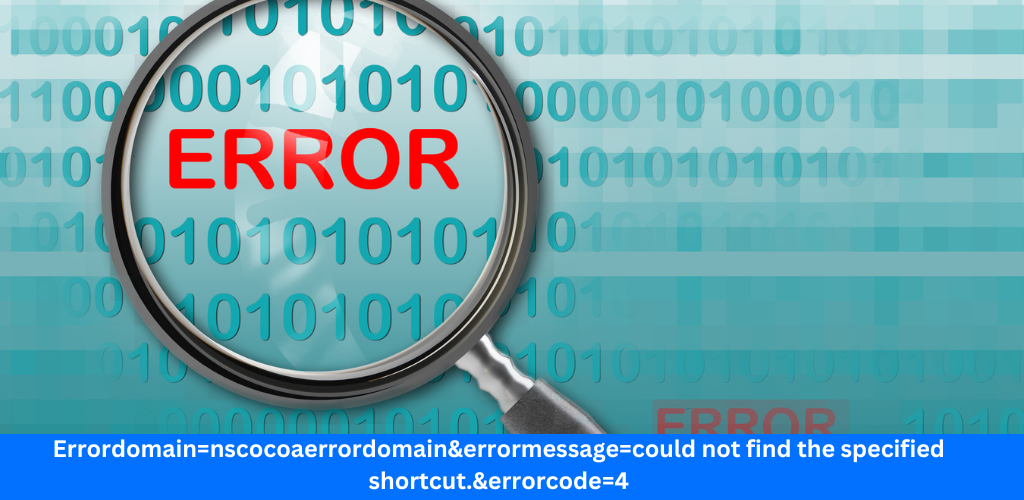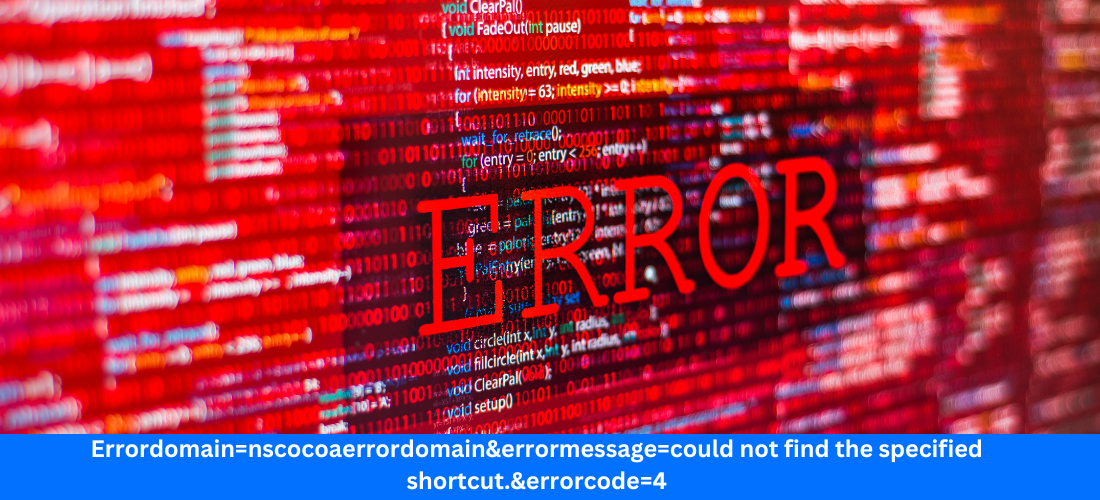Are you tired of seeing those pesky NSCocoaErrorDomain errors pop up on your screen? Don’t worry, we’ve got you covered. In this complete guide, we’ll walk you through everything you need to know about troubleshooting NSCocoaErrorDomain errors, including the dreaded Code 4. Say goodbye to frustration and hello to a smoother experience with your Mac device!
Understanding NSCocoaErrorDomain Errors
The NSCocoaErrorDomain is a domain within the Cocoa error system that deals specifically with errors related to the Objective-C programming language. These errors are commonly encountered when developing applications for Apple’s macOS and iOS operating systems. Understanding and troubleshooting these errors is an important skill for any developer working with these platforms.
What Causes NSCocoaErrorDomain Errors?
NSCocoaErrorDomain errors can occur for a variety of reasons, but they are often related to issues with data handling or file I/O operations. For example, attempting to read or write to a file that does not exist, or trying to access data in an incorrect format, can result in an NSCocoaErrorDomain error being thrown.
In addition, memory management issues such as trying to access released objects can also lead to these types of errors. It is important for developers to have a good understanding of memory management techniques in order to avoid encountering NSCocoaErrorDomain errors.
How Do I Identify NSCocoaErrorDomain Error?

When your application encounters an error within the NSCocoaErrorDomain, it will typically throw an exception which includes information about the specific error code and description. This information can be used to identify the source of the problem and begin troubleshooting.
Some common codes within this domain include:
- “NSFileNoSuchFileError”: Indicates that the specified file does not exist.
- “NSFileReadUnknownError”: Indicates that there was an unknown error while reading from a file.
- “NSPropertyListReadCorruptFileFormatError”: Indicates that there was an issue parsing a property list file due to corrupt data.
- “NSKeyedArchiveInvalidStreamVersion”: Indicates that incompatible versions of code were used when encoding and decoding archived objects.
These are just a few examples of possible codes within the NSCocoaErrorDomain – there are many more that may be encountered depending on your specific development scenario.
Read Also: Proxiyum: The Ultimate Guide to Understanding and Leveraging Its Potential
Troubleshooting NSCocoaErrorDomain Errors
Once you have identified the specific error code and description, you can begin troubleshooting the issue. This may involve checking for basic coding errors such as typos or incorrect variable types, or it could require more in-depth debugging techniques.
One helpful tool for troubleshooting these errors is the Xcode debugger, which allows developers to step through their code and see exactly where an error is occurring. Additionally, reviewing Apple’s official documentation on the NSCocoaErrorDomain and its associated codes can provide valuable insights into common causes and solutions.
By having a solid understanding of what NSCocoaErrorDomain errors are, how to identify them, and how to troubleshoot them effectively, developers can minimize downtime and ensure that their applications run smoothly.
What is Code 4?
Code 4 in NSCocoaErrorDomain errors indicates that the specified shortcut could not be found. It serves as a key identifier for troubleshooting and understanding the root cause of the issue at hand.
When encountering a Code 4 error, it’s essential to delve deeper into what led to this specific code being triggered. Understanding the context in which this error arises can provide valuable insights into potential solutions or preventive measures for future occurrences.
By grasping the significance of Code 4 within NSCocoaErrorDomain errors, users can better navigate through troubleshooting steps and address underlying issues effectively. This knowledge empowers individuals to tackle challenges with confidence and proficiency, ultimately enhancing their overall user experience.
Common Causes of NSCocoaErrorDomain Errors
NSCocoaErrorDomain errors can be a real headache for developers, especially when trying to pinpoint the root cause. One common reason behind these errors is a mismatch between the specified shortcut and its actual existence within the codebase. This discrepancy can lead to confusion and frustration as the system struggles to locate what it cannot find.
Furthermore, typos or missing characters in the shortcut name can throw off the entire process, causing errors to pop up unexpectedly. It’s crucial to pay close attention to detail when naming shortcuts to avoid running into this issue down the line.
In addition, improper formatting of shortcut codes can also trigger NSCocoaErrorDomain errors. Ensuring that your codes are correctly structured and follow any specific guidelines set by the platform can help prevent these mishaps from occurring.
Troubleshooting Steps for Code 4 Errors

Facing Code 4 errors within the NSCocoaErrorDomain can be frustrating, but fear not! Troubleshooting these issues is simpler than you might think. The first step is to verify that the specified shortcut actually exists where it should. Double-checking this small detail can save you a lot of time and effort in the long run.
Next, pay close attention to any typos or missing characters in the shortcut name. Even a minor mistake can lead to error code 4 popping up on your screen. Proper formatting of the shortcut code is crucial for smooth operation, so make sure everything is structured correctly.
If problems persist, consider clearing cache and cookies from your system. Sometimes, outdated data stored on your device can interfere with the proper functioning of shortcuts. By following these troubleshooting steps diligently, you’ll be well on your way to resolving those pesky Code 4 errors swiftly and effectively!
Verify the existence of the specified shortcut
When encountering NSCocoaErrorDomain errors with Code 4, one of the first steps in troubleshooting is to verify the existence of the specified shortcut. This simple yet crucial check can often uncover the root cause of the error and pave the way for a solution.
Start by confirming that the shortcut you are trying to access actually exists within your system or application. Double-check its name, location, and any associated parameters to ensure accuracy.
If you are unable to locate the shortcut as expected, it may be worth revisiting where it was supposed to be stored or created. A small oversight in naming or directory placement could lead to this error message.
By taking this initial verification step seriously, you set yourself up for a more targeted investigation into resolving NSCocoaErrorDomain errors related to missing shortcuts.
Check for typos and missing characters in the shortcut name
When troubleshooting NSCocoaErrorDomain errors with Code 4, checking for typos and missing characters in the shortcut name is crucial. Even a small typo or a missing character can lead to this error message: “could not find the specified shortcut.”
Take a close look at the shortcut name you are trying to access. Double-check each letter, number, or symbol to ensure it matches exactly what you have saved.
If there are any discrepancies between the actual shortcut name and what you’re inputting, correct them promptly. Pay attention to uppercase and lowercase letters as well.
Sometimes, auto-correct features or copy-pasting can introduce unexpected characters that cause errors. Manually typing in the shortcut name may help avoid these issues.
By meticulously reviewing the spelling and arrangement of characters in your shortcut’s name, you might uncover simple yet impactful mistakes causing NSCocoaErrorDomain Code 4.
Ensure proper formatting of the shortcut code
When encountering NSCocoaErrorDomain errors, ensuring the proper formatting of the shortcut code is crucial. Incorrectly formatted code can lead to issues that trigger error code 4.
To address this, pay close attention to the syntax and structure of the shortcut code. Make sure there are no extra spaces, missing brackets, or misplaced characters that could disrupt its functionality.
Checking for any special characters or symbols in the shortcut code is also essential. These elements might be causing conflicts that result in the error message “could not find the specified shortcut.”
Reviewing coding conventions and guidelines specific to your platform can help you identify and rectify any formatting errors present in your shortcut code.
By taking the time to validate and correct any formatting discrepancies in your shortcut code, you can increase the likelihood of resolving NSCocoaErrorDomain errors effectively.
Clearing Cache and Cookies
When facing NSCocoaErrorDomain errors, one often overlooked solution is clearing cache and cookies. These temporary files can sometimes cause conflicts with shortcuts, leading to Code 4 errors. By removing these stored data, you might resolve the issue swiftly.
Cache and cookies are like digital footprints of your browsing history. Over time, they can accumulate and potentially interfere with the operation of shortcuts within NSCocoaErrorDomain. Thus, performing a regular cleanup can help maintain the smooth functioning of your system.
To clear cache and cookies on different browsers or platforms, simply access the settings or preferences section and look for options related to privacy or browsing data. From there, you can choose to delete these files selectively or altogether.
Remember that clearing cache and cookies is not a universal fix for all NSCocoaErrorDomain errors but it’s a good starting point in troubleshooting Code 4 problems.
Other Possible Solutions for NSCocoaErrorDomain Errors

Having trouble with NSCocoaErrorDomain errors and not sure what to do next? Don’t worry, there are other possible solutions you can try to resolve these pesky issues. One option is to update your macOS system to the latest version, as this can sometimes resolve compatibility issues causing the error.
Additionally, checking for any pending software updates for Xcode or any related applications might help in addressing underlying conflicts triggering the NSCocoaErrorDomain errors. Another potential solution is reviewing any recent changes made to your code or system settings that could be impacting the functionality of shortcuts.
Moreover, reaching out to online forums or developer communities can provide valuable insights into troubleshooting strategies that have worked for others experiencing similar NSCocoaErrorDomain challenges. Remember, persistence and patience are key when tackling technical glitches like these – don’t give up until you find a solution!
Prevention Tips to Avoid Code 4 Errors:
To prevent NSCocoaErrorDomain errors, including Code 4, it’s essential to follow some key tips. Firstly, regularly back up your shortcuts and ensure they are stored securely. Secondly, double-check the shortcut names for accuracy before using them in your code. Additionally, stay updated with the latest software updates to avoid any compatibility issues that may lead to error messages.
By implementing these prevention tips and staying vigilant about potential issues, you can minimize the occurrence of NSCocoaErrorDomain errors and maintain a smooth workflow while coding. Remember that proactive measures can go a long way in avoiding frustrating error messages like “could not find the specified shortcut.”
Read Also: Unveiling Worldwide Science Stories: The Future of Global Scientific Advancements
Conclusion
In conclusion, troubleshooting NSCocoaErrorDomain errors can be a frustrating and time-consuming process. However, by following the steps outlined in this guide and understanding the common causes of these errors, you can quickly resolve them and get your application back up and running smoothly. Remember to always double-check your code for any potential mistakes or missing information, as well as keeping an eye out for any system updates that may affect your app’s functionality. With patience and persistence, you will conquer those pesky NSCocoaErrorDomain errors in no time!




